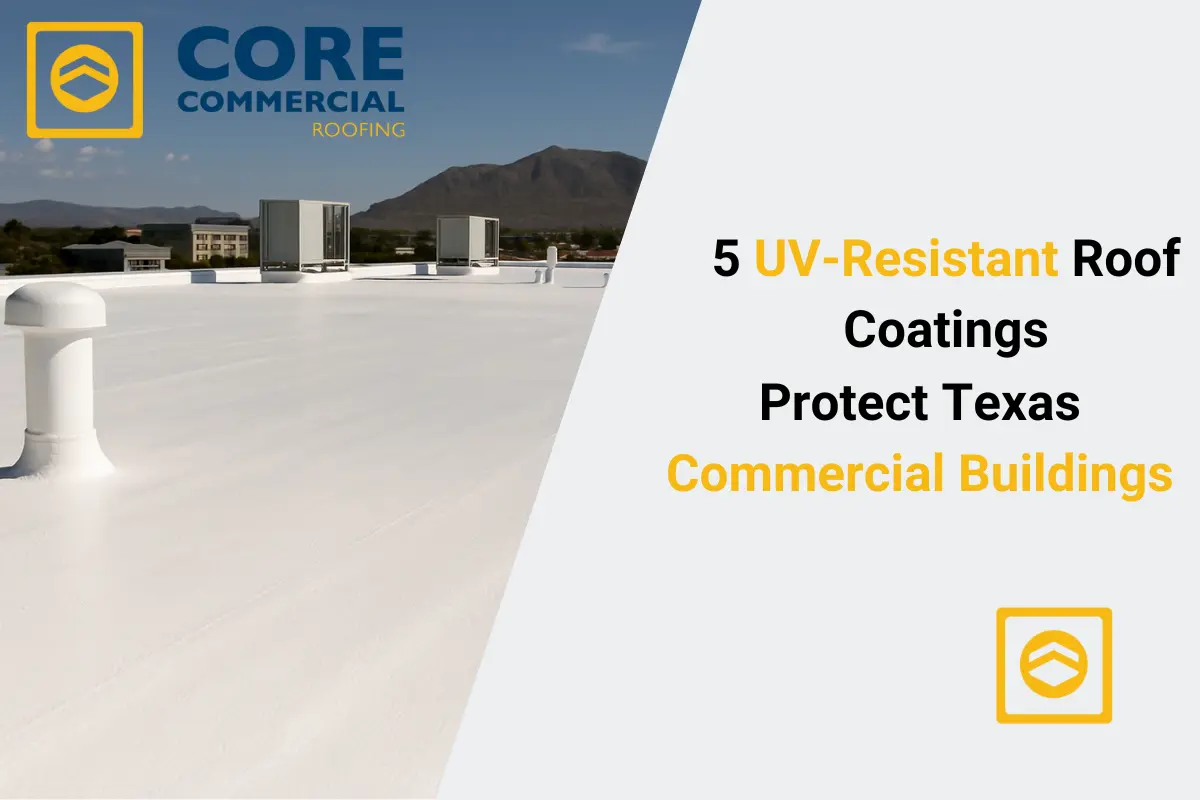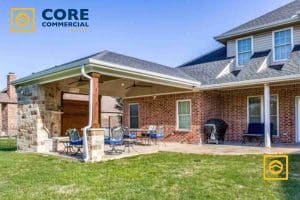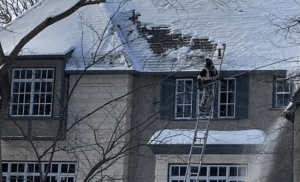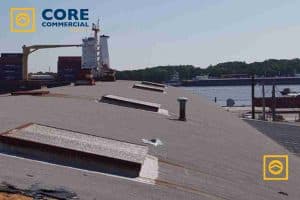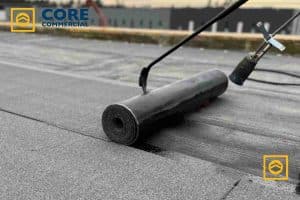Texas commercial buildings face some of the harshest roofing conditions in the country. Long stretches of blazing sun, sudden heat waves, and heavy summer storms create the perfect recipe for roof damage. Without extra protection, roofing materials weaken faster, leading to leaks, high cooling bills, and costly early replacements. One of the most effective solutions is applying a UV-resistant roof coating, which acts like sunscreen for your building.
Among the many options, silicone roof coatings stand out for their ability to handle extreme heat and ponding water, making them an excellent choice for flat and low-slope roofs. But silicone isn’t the only option—other coatings like acrylic, polyurethane, asphalt emulsion, and fluoropolymer offer unique advantages depending on your roof type and long-term goals. In this article, we’ll explore these coatings in detail, helping you choose the right protection to extend your roof’s lifespan and lower energy costs.

Table of Contents
In this guide, we’ll walk you through five of the best UV-resistant roof coatings that are perfectly suited for the Texas climate. We’ll explain how each works, why it matters, and how it can help solve real problems like heat buildup, leaks, and early roof failure.
Why UV‑Resistant Roof Coatings Are Crucial in Texas
The Texas Climate Challenge
Texas experiences over 200 sunny days per year, and in places like Dallas, Houston, Austin, and San Antonio, UV levels can be dangerously high. Without protection, commercial roofing materials — especially flat or low-slope roofs — degrade faster, crack, warp, or lose adhesion. This leads to leaks, heat retention, high cooling costs, and expensive early replacements.
The Real Cost of UV Damage
- Energy Loss: Sun-heated roofs increase indoor temperatures, forcing HVAC systems to work harder.
- Water Leaks: UV rays break down roofing membranes, creating weak spots where water can seep in.
- Shortened Roof Life: Constant sun exposure reduces a roof’s lifespan by years.
- Repairs and Replacements: Roof damage is expensive and disruptive to business operations.
UV-resistant coatings create a reflective, durable barrier that helps your building beat the heat — literally and financially.
Key Benefits of UV-Resistant Roof Coatings
- Lower cooling costs by up to 30%
- Extend roof lifespan by 10-20 years
- Minimize the risk of leaks and cracks
- Improve comfort for tenants and employees
- Qualify for energy rebates or tax credits
- Reduce the urban heat island effect
Now, let’s break down the top 5 roof coatings that can protect your Texas commercial building from harmful UV rays.
1. Silicone Roof Coatings
Best For: Flat or low-slope roofs with ponding water issues
Silicone coatings are one of the most popular and effective choices for buildings in hot climates. They form a seamless, rubber-like membrane that resists UV radiation, rain, and standing water.
Benefits:
- Highly reflective: Can reflect over 85% of solar energy
- Excellent UV stability: Doesn’t chalk or degrade quickly
- Low maintenance: Long-lasting with minimal upkeep
- Waterproof: Perfect for roofs that collect water during storms
Why It Works in Texas:
Silicone stands up well to the triple threat of UV, heat, and humidity, making it a go-to for buildings from Houston to El Paso.
2. Acrylic Roof Coatings
Best For: Metal and built-up roofing systems
Acrylic coatings are water-based and cost-effective, offering strong UV protection and energy savings. They are easy to install and suitable for roofs that don’t deal with heavy standing water.
Benefits:
- Budget-friendly: Lower material and installation costs
- UV reflective: Keeps buildings cooler during peak summer months
- Environmentally friendly: Low-VOC and safe to apply
- Flexible finish: Adapts to roof movement and temperature changes
Why It Works in Texas:
Great for large retail or warehouse buildings in places like Dallas or San Antonio, where sun exposure is extreme but water drainage is efficient.
3. Polyurethane Roof Coatings
Best For: High-traffic roofs and mechanically fastened systems
Polyurethane coatings offer the perfect blend of durability and flexibility. They’re especially good for commercial buildings that see foot traffic on the roof or are located in storm-prone areas.
Benefits:
- Tough surface: Resists impact and mechanical wear
- Strong UV resistance: Slows down sun-related damage
- Adheres well: Works on a variety of substrates
- Flexible: Handles thermal expansion and contraction
Why It Works in Texas:
It is ideal for multistory office buildings, hospitals, or schools with rooftop HVAC units or maintenance staff, especially in stormy regions like Houston or the Gulf Coast.
4. Asphalt Emulsion with Reflective Topcoat
Best For: Built-up roofing systems with minor repairs
Asphalt emulsion coatings are made from asphalt particles suspended in water. While not UV-resistant, they’re often used with reflective topcoats like aluminum or acrylic to provide long-term UV defense.
Benefits:
- Cost-effective base layer: Excellent for roofs needing extra structural support
- Paired with UV topcoat: Combine strength with reflectivity
- Seals small cracks and gaps: Prevents leaks before they grow
Why It Works in Texas:
This combo provides a solid, repair-friendly solution for aging roofs across Texas, especially older school or government buildings.
5. Fluoropolymer Roof Coatings
Best For: Long-term investment in premium protection
Fluoropolymer coatings are the high-end solution for roofs that demand the best in UV resistance and durability. These coatings don’t degrade easily and are designed to last 20+ years.
Benefits:
- Unmatched UV resistance: Maintains reflectivity and color for decades
- Resists dirt and stains: Keeps your roof looking clean longer
- Minimal maintenance: Rarely needs recoating
- Energy-efficient: Helps lower cooling loads year-round
Why It Works in Texas:
Ideal for corporate headquarters, LEED-certified buildings, or green commercial developments where long-term ROI and aesthetics matter — perfect for Austin or new construction in suburban business parks.
Choosing the Right Coating for Your Texas Building
When deciding on a roof coating, consider:
- Roof slope and material
- Exposure to standing water
- Amount of rooftop foot traffic
- Local UV index and heat levels
- Budget and long-term goals
For example:
- Got an older flat roof in humid Houston? Go with silicone.
- Running a big-box store in Dallas? Acrylic may offer the best ROI.
- Managing a multi-use building in Austin’s tech corridor? Fluoropolymer gives lasting results.
Bonus Tip: Don’t Forget About Color
Light-colored coatings — especially white or light gray — reflect more sunlight. This boosts energy efficiency and reduces the burden on your cooling system. Always opt for reflective coatings when available.
Maintenance Matters
Even the best coating won’t last forever without regular maintenance. To maximize protection:
- Inspect your roof every 6 months
- Remove debris and dirt
- Patch cracks or blisters early
- Recoat as needed (usually every 10–20 years)
Set a maintenance schedule with your roofing contractor to avoid surprises.
Conclusion: Protect Your Investment With the Right Coating
A commercial roof is one of the most valuable assets of any building—and in Texas, it needs extra protection to stand up to relentless sun and storms. UV-resistant roof coatings are not just a quick fix. They are a smart, cost-effective strategy that leads to:
- Lower energy bills
- Fewer roof repairs
- Extended roof life by decades
- More comfortable and efficient buildings
By understanding your roof type, climate challenges, and long-term goals, you can select the coating that delivers the best results. Whether it’s silicone for flat roofs, acrylic for cost-savings, polyurethane for traffic resistance, asphalt emulsion for older systems, or fluoropolymer for premium protection, the right choice ensures your roof withstands Texas weather for years to come.
FAQs
What is the best UV-resistant roof coating in Texas?
In Texas, silicone roof coatings are often considered the best for UV resistance due to their durability and ability to withstand ponding water. They reflect sunlight effectively, reducing heat absorption and extending the roof’s lifespan.
How does UV-resistant roof coating save energy costs?
UV-resistant coatings reflect a significant portion of the sun’s rays, lowering roof temperatures. This reduces the need for air conditioning, leading to lower energy bills, especially during Texas’s hot summers.
Can roof coatings extend the life of commercial roofs?
Yes, applying a UV-resistant coating can add 10-20 years to a roof’s life by protecting it from sun damage, reducing thermal expansion, and preventing leaks.
Are there energy rebates for cool roof coatings in Texas?
Some Texas utility companies offer rebates for installing energy-efficient roofing solutions, including reflective roof coatings. It’s advisable to check with local programs for specific incentives.
How often should commercial roof coatings be reapplied?
Typically, roof coatings should be inspected annually and reapplied every 10-15 years, depending on the coating type and environmental conditions.
Which roof coating is best for flat commercial roofs in Texas?
Silicone coatings are ideal for flat roofs in Texas as they handle ponding water well and provide excellent UV protection, crucial for the state’s climate.
Do roof coatings help with water leaks?
Yes, roof coatings create a seamless barrier that seals small cracks and prevents water infiltration, effectively addressing minor leaks.
Is roof coating suitable for metal commercial roofs in Texas?
Absolutely. Coatings like acrylic and silicone adhere well to metal roofs, offering UV protection and preventing rust, which is beneficial in Texas’s varied climate.
What is the cost difference between roof coating and replacement?
Roof coatings are generally more cost-effective, often costing less than half of a full roof replacement, while also extending the existing roof’s life.
Can roof coatings be applied over existing roofs?
Yes, most UV-resistant coatings can be applied over existing roofs after proper cleaning and preparation, making them a convenient option for maintenance and energy efficiency improvements.

